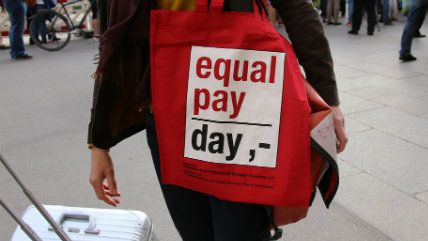'Equal Pay for Equal Work?' We're Almost There
In a 33-country study, the pay gap between men and women working the same jobs was just 1.6 percent.

"Equal pay for equal work" has become a hot rallying cry once again. While it varies slightly depending on the source, the general axiom is that women workers make just 75 to 85 percent of what their male counterparts do. And that is correct—when you compare the average female wages within a company, country, or employment sector to average male wages in that area. But when you consider men and women performing substantially similar jobs—i.e., situations in which the sexes are actually doing "equal work"—the wage gap shrinks significantly. A new examination of wage data from 33 countries around the world found that for men and women in the same position, men made just 1.6 percent more on average.
The study, from the Hay Group, encompassed more than 8 million workers. Overall, women were found to earn about 18 percent less than men, a finding researchers attribute to the lack of women in high-paying executive roles and their over-representation in areas such as service and clerical work.
Broken down by country, the only place where the wage gap favored women was the United Arab Emirates (UAE), where female workers made about 2 percent more than male workers in the same positions. The overall wage gap there also worked in women's favor, albeit very slightly, with women's wages outpacing men's by less than one percent.
Mexico, the U.K., Russia, the Netherlands, and Spain were among countries with the highest gaps between female and male wages, with men making around 25 to 35 percent more on average. But the wage gap between men and women in the same position was virtually non-existent in Russia, and in no country was it over five percent.
In a classic shifting-goalposts move, many progressives will now tell you that of course they haven't been meaning to imply that men make 25-35 percent more than women working the same jobs. (To be clear, many fighting for "equal pay" will still tell you that that's exactly what the "gender wage gap" references.) They know that the larger gap comes from comparing all workers within a company, country, etc., but that even so, it's a troubling number because it shows how women are still lacking in leadership roles and clustered in certain job sectors that tend to be less remunerative.
Whether those are issues we should even want to or can "solve" is an argument for another time, but we can probably all agree that they are different issues, qualitatively, than women being economically discriminated against by employers, not negotiating their pay hard enough, or any of the other things floated as reasons why women earn less. Men and women working the same jobs are managing to make the same salaries pretty well, it seems. If we want to talk about whether we need and how to get more women CEOs or senators or STEM majors, fine, but that conversation will be better served by not unnecessarily conflating it with the issue of "equal pay."


Show Comments (62)